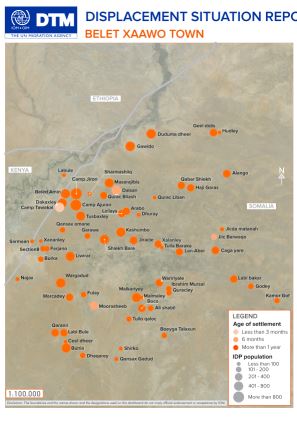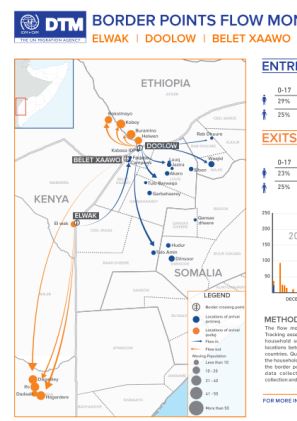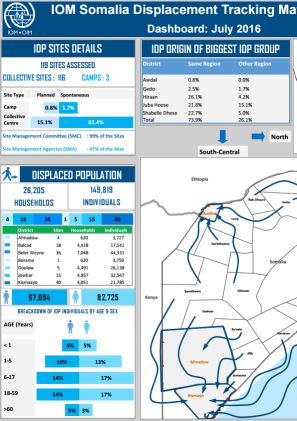-
Countries
-
Data and Analysis
-
Special Focus
-
Crisis Responses
Somalia
Somalia
IDPs tracked
Displacement Movements
3,862,000
IDMC 2023
Data collection round
About Somalia
IOM Somalia Displacement Tracking Matrix (DTM) aims to collect, analysis and disseminate information on displacement. DTM is IOM’s information management system to track and monitor numbers, locations, movements, needs and vulnerabilities of displaced people. The data outputs, including reports, maps, datasets and online interactive resources, support responses in humanitarian crisis, evidence-based decision making, durable solutions programming and migration research. DTM Somalia was first launch in 2016.
Since the collapse of the Somali central government in 1991, Somalia has suffered a highly complex protracted conflict characterized by changing political dynamics and power shifts. Forced displacement remains an ongoing reality for people living in Somalia due to conflict, environmental hardships, combined with inadequate resource distribution that is often exacerbated by clan-based, ideological differences and land and natural resource competition. Natural hazards, including drought and flooding, combined with widespread security threats have caused one of the world’s largest displacement crises, with 3.8 million IDPs recorded at the end of 2022. Somalia also has a strategic geographical position on the eastern route, which connects the Horn of Africa to the Gulf countries, representing one of the most dangerous and frequented migration corridors in the world.
Current Donors
- EU
- ECHO
- BHA
- Canada
- JSB
- World Bank
Somalia — Displacement Situation Report Johawar (June 2017)
Over the past 5 years, Middle Shabelle has faced multiple calamities with the top three causes of displacement being drough, insecurity, and outbreak of disease.
Somalia — Displacement Situation Report Doolow (June 2017)
The Gedo region remains home for most people affected by the prolonged drought, conflict and disease outbreak. This has resulted in an increase of IDPs coming to urbanized areas in Doolow district for service porvision.
Somalia — Displacement Situation Report Belet Xaawo (June 2017)
The Gedo region remains home for most people affected by the prolonged drought, conflict and disease outbreak. Belet Xaawo town, the most populated location in Belet Xaawo district hosts a total of 31,789 IDPs.
Somalia — Displacement Situation Report Belet Weyne (June 2017)
Since November 2016 to June 2017, Hiraan region has seen a total of 11,864 IDPs and earlier than usual pastoralist movement related to drought, with many moving from rural areas to populated places with a perceived availability of services.
Somalia — Displacement Situation Report Balcad (June 2017)
Over the 5 years, Middle Shabelle has faced multiple natural and man-made hazards.
Somalia — Displacement Situation Report Afmadow (June 2017)
Afmadow district has experienced an influx of 58,100 IDPs from Middle Juba, Lower Juba and Bay as a result of insecurity, natural disaster and search for humanitarian assistance. Most sites in the district are spontaneous, and unnamed.
Somalia — Displacement Situation Report Galgaduud Region (June 2017)
Galgadud region remains at the epicenter of continued insecurity. The withdrawal of African Union Mission in Somalia (AMISOM) and local troops from locations in El Bur and subsequent take-over by insurgents has sparked new waves of insecurity and displacement.
Somalia — Displacement Situation Report Gaalckacyo District (June 2017)
In Gaalckacyo, Mudug region, severe drought conditions have become the primary reason for migration into urban and peri-urban areas.
Somalia – Displacement Situation Report Baidoa (May 2017)
Over the past six months, severe drought conditions have contributed to the displacement of more than a half a million people across the country. Baidoa town (Baidoa district, Bay region), currently hosts one of the highest caseloads of drought displaced people in the country.
Somalia — Drought Related Displacement (April 2017)
During the reporting period, DTM Somalia recorded 75,366 displaced persons as displayed on the map.
Somalia – Border Point Flow Monitoring (April 2017)
During the reporting period DTM Somalia recorded 283 new entries (a 138% increase between March and April) and 871 new exits (a 33% decrease between March and April).
Somalia — Drought Situation Overview 4 (26 February 2017)
Between 1 January and 26 February 2017, at least 138,000 individuals in Somalia have been internally displaced. A majority of these IDPs come from Bay, Bari, Gedo, Mudug, Galgaduud and Middle Shbelle. Drought conditions prevail in South Central as well as in other parts of Somalia.
Somalia — Drought Related Displacement (January – February 2017)
A map indicating areas of drought related displacement in Somalia.
Somalia — Displacement Dashboard 4 (February 2017)
Between January and February 2017, DTM found that 23,248 people have been newly displaced, bringing the total population displaced to 431,634 people.
Somalia — Displacement Alert (4 January 2017)
As a result of lower than average rainfall there was an influx of IDPs into two states, Luuq and Doolow. An estimated 800 households were displaced to Doolow and 1,500 households were displaced to Luuq. District officials estimate over 90,000 persons affected as of 9 January 2017.
Jan 04 2017
Somalia — Displacement Alert (4 January 2017)
Somalia — Displacement Report 3 (October 2016)
Patterns of internal displacement in Somalia are diverse: short and long-term, single or multiple events, protracted or newly emerging, in both rural and urban areas. This diversity needs to be reflected for appropriate solutions to be developed and pursued.
Oct 31 2016
Somalia — Displacement Report 3 (October 2016)
Somalia — Displacement Dashboard 2 (July 2016)
In Round 2 DTM Somalia assessed 119 sites. Of these sites 116 were collective sites and 3 were camps. The total number of individual IDPs across these sites and during this period was 149,819. Of these, 63 per cent were below the age of 17 and 31 per cent were between 18-59 years old.
Jul 31 2016
Somalia — Displacement Dashboard 2 (July 2016)
Somalia — Displacement Report 2 (July 2016)
In Round 2 DTM Somalia assessed 119 sites. The total number of individual IDPs across these sites and during this period was 430,062. Of these 119,106 had been displaced within the same region, 93,721 (62.6%) were below the age of 17 and 47,388 (31.6%) were between 18-59 years old.
Jul 31 2016
Somalia — Displacement Report 2 (July 2016)
Somalia — Displacement Dashboard 1 (June 2016)
The total number of IDPs for this round was 430,062. Of these 64% were living in collective settlements and 36% were living within host communities.
Jun 30 2016
Somalia — Displacement Dashboard 1 (June 2016)
Somalia — District Profiles 1 (June 2016)
A compilation of profiles for the districts of: Afmadow (54, 984 IDPs), Balcad (27,282 IDPs), Belet Weyne (132,204 IDPs), Borama (14,130 IDPs), Doolow (56, 436 IDPs), Jowhar (87,786 IDPs), Kismaayo (57,240 IDPs).
Jun 30 2016
Somalia — District Profiles 1 (June 2016)
Somalia — Displacement Report 1 (June 2016)
With protracted conflicts, reoccurring floods and drought as well as ongoing evictions in urban areas, the estimated internally displaced population (IDP) in Somalia stood at over 1.1 million in 2016. Within June 2016 DTM recorded 430, 062 IDPs.
Jun 30 2016
Somalia — Displacement Report 1 (June 2016)
Pagination
- First page
- Previous page
- …
- 9
- 10
- 11
- 12
- 13
- 14
- 15
- 16
- 17























